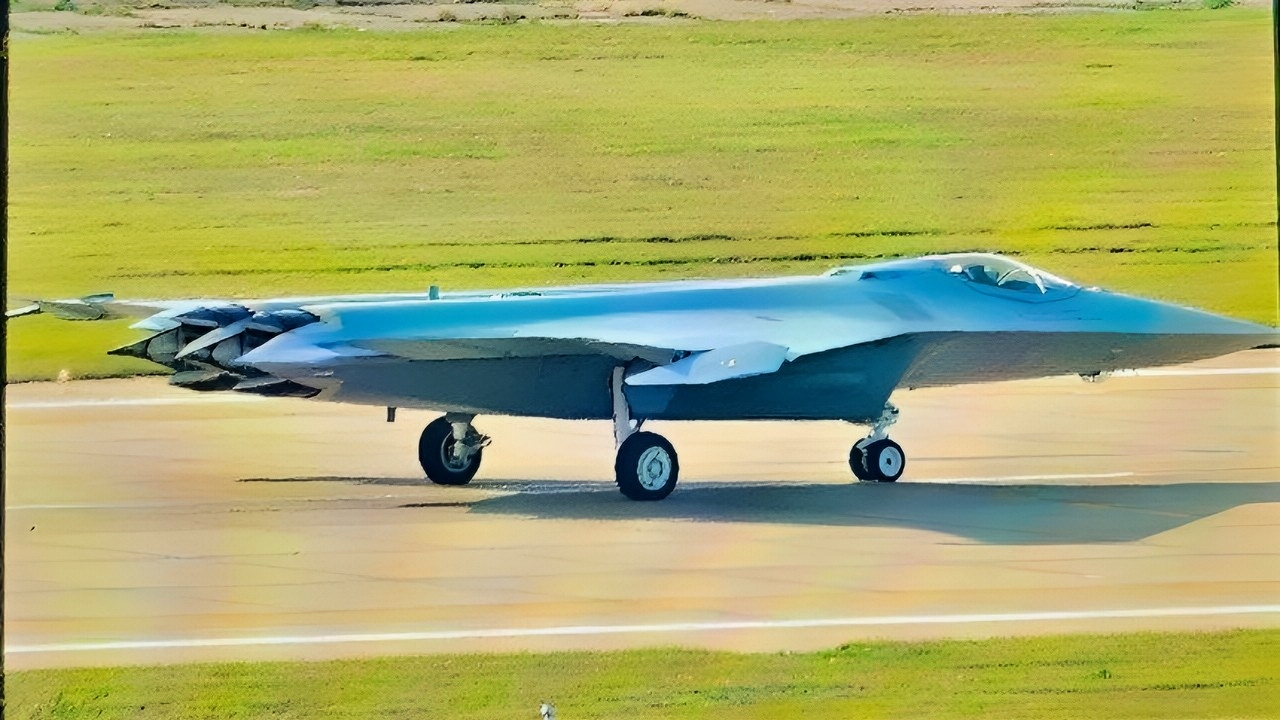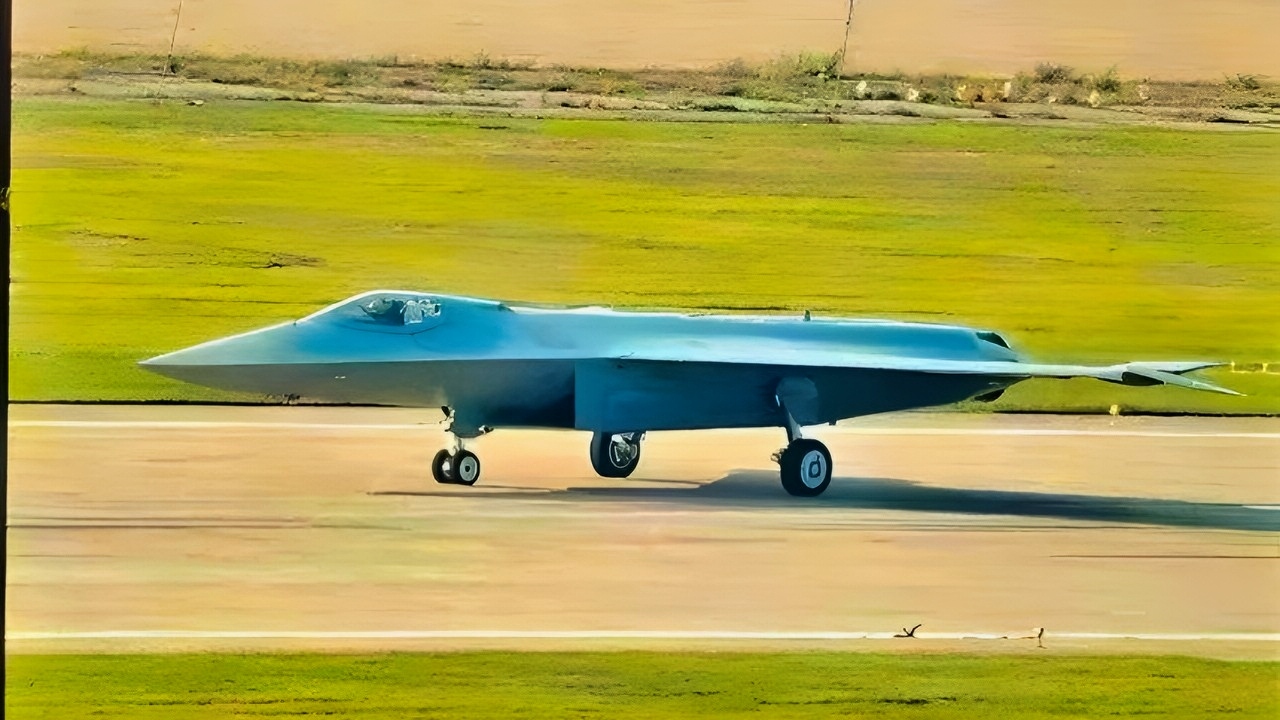Key Points and Summary – Fresh close-ups of China’s tailless J-50 (J-XDS) prototype reveal key sixth-gen traits: a broad, diamond-shaped nose, diverterless intakes, F-22-style thrust-vectoring nozzles with serration, and striking swiveling wingtips likely aiding low-speed control.
-The latest images—unverified but consistent with prior leaks—omit the earlier nose data boom, hinting at a new test phase.
-A single-seat cockpit, blended canopy, EO/targeting sensor under the fuselage, and possible DAS apertures also appear.
-Paired with Chengdu’s larger J-36, the J-50 suggests a two-track PLAAF approach. If flight testing continues apace, Beijing could field an operational sixth-gen system around 2030—pressuring U.S. F-47 NGAD timelines.
We Just Got A Close-Up Of China’s J-50
What may be the clearest imagery so far of China’s tailless 6th-generation fighter has just surfaced online, offering fresh insight into Beijing’s ambitions for its sixth-generation fleet.
The jet – known as the J-XDS and sometimes referred to as the J-50 – is believed to be a Shenyang Aircraft Corporation design.
The photographs, if genuine, confirm several long-suspected features of the aircraft that will directly compete with the United States’ NGAD design.

J-50 Fighter Image from X
Among those features are a broad, diamond-shaped noise, a diverterless supersonic intake design, and F-22-style thrust-vectoring nozzles with serrated edges designed to minimize radar detection.
Most striking, however, is the absence of vertical tails and the presence of swiveling wingtips – an unusual control system that could potentially have been designed to help stabilize the aircraft at low speeds.
The images, which appeared on X and were also published by The War Zone, are still unverified – but the design matches earlier, lower-quality shots of the same airframe that also appeared on social media.
One notable difference, however, is the absence of a nose-mounted air data boom that was seen in previous test flights.
That data boom – an instrument designed to collect precise information about airspeed, angle of attack, and more during test flights – may have been removed as a result of the aircraft moving into new testing stages.
It could, therefore, indicate that the aircraft is rapidly moving through the testing process and could be preparing for deployment.
While there is no confirmed public source indicating a firm entry-into-service (EIS) date for the J-50, analysts speculate that China is aggressively pursuing the development of the jet with the intention of beating the United States to be the first to field a sixth-generation fighter.
Some speculate that China may aim to deploy the J-50, or variants, around 2030.
While it remains unclear whether the J-XDS seen in the recent images is a demonstrator or a production-representative prototype, China’s recent pace of development makes the latter plausible – and arguably, likely.
The jet was first seen in late 2024 alongside the larger, twin-engine J-36, which has since been photographed in greater detail.
The Design So Far
The new images provide valuable side and forward views of the long-rumored aircraft, revealing what looks to be a blended canopy design and a single-seat cockpit. That single-seat configuration could finally settle speculation and debate over whether this will be a two-seater aircraft designed for long missions.
Additionally, an electro-optical targeting system can be seen underneath the fuselage, along with small side bays. It remains unclear exactly what the purpose of those side bays is, however.
Visible bulges behind the cockpit also hint at the possibility of embedded apertures for a distributed aperture system (DAS).
Strategic Implications
Together with the larger J-36 – reportedly a delta-wing fighter-bomber design with its own stealth-optimized, tailless configuration – the J-50 represents Beijing’s two-track approach to developing its sixth-generation fleet.
Chengdu and Shenyang, the country’s two major design houses, appear to be developing two parallel solutions, much in the same way that the United States is pursuing separate concepts for the Air Force and Navy.
The J-36, with its heavy delta wing and long-range ability, appears to be built for deep strike and stand-off roles – potentially operating alongside stealth bombers. The smaller and more agile J-50, meanwhile, could well serve as a tactical platform that is capable of surviving in strongly-defended environments by leveraging its advanced stealth and sensor fusion technology.

J-36 Fighter from China. Image Credit: Creative Commons.
If both programs mature, the People’s Liberation Army Air Force (PLAAF) could eventually field a complementary family of next-generation aircraft rather than a single aircraft.
The timing matters, too. Reports suggest that both jets first flew in December 2024. Since then, sightings have only multiplied, with recent video showing the J-50 in flight and lowering its landing gear. Even with limited public specifications, its siveling wingtips, thrust-vectoring engines, and electro-optical targeting sensors represent a significant leap in China’s aerial abilities.
For Washington and its allies, the progress should serve as a warning that competing sixth-generation programs must not experience any further delays. The U.S. Air Force aims to fly its F-47 NGAD prototype by 2028, with the Navy’s F/A-XX expected to follow sometime in the 2030s.
But China’s ability to put multiple sixth-generation prototypes into the air within such a compressed timeframe raises the possibility that the PLAAF could well beat the U.S. Air Force to become the first to field an operational sixth-generation system.
About the Author:
Jack Buckby is a British author, counter-extremism researcher, and journalist based in New York who writes frequently for National Security Journal. Reporting on the U.K., Europe, and the U.S., he works to analyze and understand left-wing and right-wing radicalization, and reports on Western governments’ approaches to the pressing issues of today. His books and research papers explore these themes and propose pragmatic solutions to our increasingly polarized society. His latest book is The Truth Teller: RFK Jr. and the Case for a Post-Partisan Presidency.
More Military
B-1B Lancer: The Bomber The Air Force Needs to Keep Flying
Su-37 ‘Terminator’: The Thrust-Vectoring Super Flanker Fighter That Never Was
Russia or China Would Love to Have the Aircraft Carrier USS Harry S. Truman
NATO’s Big Fear: Putin Drops a Tactical Nuclear Weapon on Ukraine
The U.S. Military’s Big F-22 Raptor Stealth Fighter Mistake Cuts Deep











Exodus 20:7 KJV
September 28, 2025 at 1:24 pm
The American consumer should be proud of financing our #1 enemy’s new weapon. Soon to be used against US.
Foolish Americans!🤮🤮🤮
David L Faught
September 28, 2025 at 2:01 pm
YEP.. SURE LOOKS LIKE ONE OF OURS THAT’S STILL ON THE DRAWING BOARDS.
Alex Emmett
September 28, 2025 at 2:27 pm
As communist have proven time and time again, no matter how much innovation and technology they steal from the free world, it’s never as good as the real thing. Nobody is sweating a communist developed airplane.
Doyle
September 28, 2025 at 10:46 pm
The US has been flying a 6th gen prototype for five years, catch up chicken little.
DindunNuffin
September 29, 2025 at 8:31 pm
wow looks fancy… what’s the avionics package? I bet the radar and sensors are from the F-14…